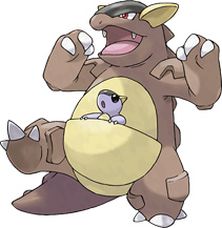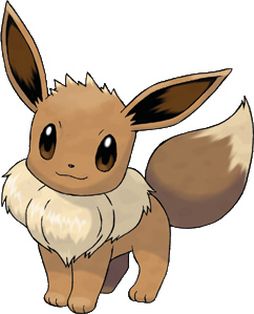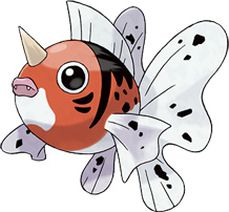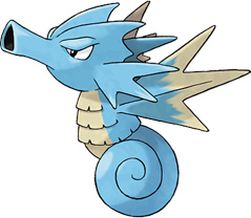
Kangaskhan is based on a kangaroo with elements of Mongolian Laminar armour, evident in its helmet-like plate with ear flaps and its epaulettes.
Kangaskhan may be a combination of kangaroo and Genghis Khan, who was the notoriously violent founder and Emperor of the Mongol Empire. This possibly is in reference to how its Pokédex data refers to it becoming “violently enraged” when protecting its child.
Garura is derived from カンガルー (kangaroo) and ルーラー (ruler).
No: 115
English Name: Kangaskhan
Japanese Name: Garura
Generation: 1
Type: Normal
Species: Parent Pokémon
Abilities: Early Bird, Scrappy, Inner Focus (hidden ability)
Evolution: –
Kangaskhan is a large, bipedal creature with a thick tail. It has a brown hide with several raised patches, and a cream-colored belly. On top of its head is a black patch, and it has large cream-colored ears and red eyes. Its snout is short and rounded with two pointed teeth protruding from its upper jaw. There are epaulette-like growths over its shoulders and a row of spikes down its back. It has three clawed digits on each hand and foot. In the pouch on its belly, it carries a baby Kangaskhan. Unlike its parent, the baby is light purple and has smooth skin. Kangaskhan is a female-only species with no male counterpart.
As Mega Kangaskhan, the mother Kangaskhan appears unchanged. However, the baby has grown into a child and gained some new features. There are now raised patches on its knees similar to those seen on its mother. These patches also appear aligned horizontally along its belly. Small, spiked growths appear underneath its ears. The child is feisty, hates to lose and will boldly challenge its opponents to protect its mother.[1] The mother’s happiness over its child’s growth is the source of its additional strength. However, it feels uneasy about the child’s future, as it is only skilled at fighting and nothing else.
Kangaskhan is a nurturing Pokémon that protects its young at all costs. The baby leaves the pouch only rarely until it is three years old. In order to avoid crushing the baby, Kangaskhan sleeps standing up. If the mother feels the environment is safe, it will allow its young out to play. However, it will violently attack anything that it sees as a threat to its young. Regardless of how badly injured it becomes, the mother will not cease fighting until its young is safe. Although it was nearly hunted to extinction, Kangaskhan can be found in savannahs and other grasslands.
POKEDEX ENTRIES
Pokemon Red: The infant rarely ventures out of its mother’s protective pouch until it is 3 years old.
Pokemon Blue: The infant rarely ventures out of its mother’s protective pouch until it is 3 years old.
Pokemon Yellow: Raises its young in its belly pouch. Won’t run from any fight to keep its young protected.
Pokemon Stadium: The female raises its young in its belly pouch for around three years. The young is taken out once it learns to find food.
Pokemon Gold: If it is safe, the young gets out of the belly pouch to play. The adult keeps a close eye on the youngster.
Pokemon Silver: To protect its young, it will never give up during battle, no matter how badly wounded it is.
Pokemon Crystal: To avoid crushing the baby it carries in its pouch, it always sleeps standing up.
Pokemon Stadium 2: If it is safe, the young gets out of the belly pouch to play. The adult keeps a close eye on the youngster.
Pokemon Ruby: If you come across a young Kangaskhan playing by itself, you must never disturb it or attempt to catch it. The baby Pokémon’s parent is sure to be in the area, and it will become violently enraged at you.
Pokemon Sapphire: If you come across a young Kangaskhan playing by itself, you must never disturb it or attempt to catch it. The baby Pokémon’s parent is sure to be in the area, and it will become violently enraged at you.
Pokemon Emerald: If you come across a young Kangaskhan playing by itself, never try to catch it. The baby’s parent is sure to be in the area, and it will become violently enraged.
Pokemon FireRed: The female raises its offspring in a pouch on its belly. It is skilled at attacking using Comet Punch.
Pokemon LeafGreen: The infant rarely ventures out of its mother’s protective pouch until it is 3 years old.
Pokemon Diamond: It raises its offspring in its belly pouch. It lets the baby out to play only when it feels safe.
Pokemon Pearl: It raises its offspring in its belly pouch. It lets the baby out to play only when it feels safe.
Pokemon Platinum: It raises its offspring in its belly pouch. It lets the baby out to play only when it feels safe.
Pokemon HeartGold: If it is safe, the young gets out of the belly pouch to play. The adult keeps a close eye on the youngster.
Pokemon SoulSilver: To protect its young, it will never give up during battle, no matter how badly wounded it is.
Pokemon Black: It raises its offspring in its belly pouch. It lets the baby out to play only when it feels safe.
Pokemon White: It raises its offspring in its belly pouch. It lets the baby out to play only when it feels safe.
Pokemon Black 2: It raises its offspring in its belly pouch. It lets the baby out to play only when it feels safe.
pokemon White 2: It raises its offspring in its belly pouch. It lets the baby out to play only when it feels safe.
Pokemon X: It raises its offspring in its belly pouch. It lets the baby out to play only when it feels safe.
Pokemon Y: If it is safe, the young gets out of the belly pouch to play. The adult keeps a close eye on the youngster.
Pokemon Omega Ruby: If you come across a young Kangaskhan playing by itself, you must never disturb it or attempt to catch it. The baby Pokémon’s parent is sure to be in the area, and it will become violently enraged at you.
Pokemon Alpha Sapphire: If you come across a young Kangaskhan playing by itself, you must never disturb it or attempt to catch it. The baby Pokémon’s parent is sure to be in the area, and it will become violently enraged at you.
Pokemon SUN: Kangaskhan’s maternal love is so deep that it will brave death to protect its offspring.
Pokemon MOON: The child in its pouch leaves home after roughly three years. That is the only time the mother is heard to cry wildly.



